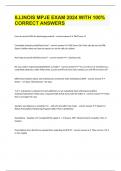Samenvatting
Molecular Therapy Summary (NWI-BM078) - Radboud University
- Vak
- Instelling
A detailed summary of the lectures from the course Molecular Therapy. It does not include a detailed summary of week 5, lecture: kinase receptor signaling. It also includes the research highlight: mitochondrial carrier proteins, nanoparticle delivery in mice and renal replacement therapies. Further...
[Meer zien]












